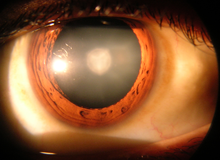| Cataract | |
|---|---|
 | |
| Magnified view of a cataract seen on examination with a slit lamp | |
| Specialty | Ophthalmology |
| Symptoms | Faded colors, blurry vision, halos around light, trouble with bright lights, trouble seeing at night[1] |
| Complications | Falling, depression, blindness[2][3] |
| Usual onset | Gradual[1] |
| Causes | Aging, trauma, radiation exposure, following eye surgery, genetic[1][4][5] |
| Risk factors | Diabetes, smoking tobacco, prolonged exposure to sunlight, alcohol[1] |
| Diagnostic method | Eye examination[1] |
| Prevention | Sunglasses, not smoking[1] |
| Treatment | Glasses, cataract surgery[1] |
| Frequency | 60 million (2015)[6] |
A cataract is a clouding of the lens of the eye which leads to a decrease in vision.[1] Cataracts often develop slowly and can affect one or both eyes.[1] Symptoms may include faded colors, blurry or double vision, halos around light, trouble with bright lights, and trouble seeing at night.[1] This may result in trouble driving, reading, or recognizing faces.[7] Poor vision caused by cataracts may also result in an increased risk of falling and depression.[2] Cataracts cause half of all cases of blindness and 33% of visual impairment worldwide.[3][8]
Cataracts are most commonly due to aging but may also occur due to trauma or radiation exposure, be present from birth, or occur following eye surgery for other problems.[1][4] Risk factors include diabetes, smoking tobacco, prolonged exposure to sunlight, and alcohol.[1] The underlying mechanism involves accumulation of clumps of protein or yellow-brown pigment in the lens that reduces transmission of light to the retina at the back of the eye.[1] Diagnosis is by an eye examination.[1]
Prevention includes wearing sunglasses, a wide brimmed hat, eating leafy vegetables and fruits, and avoiding smoking.[1][9] Early on the symptoms may be improved with glasses.[1] If this does not help, surgery to remove the cloudy lens and replace it with an artificial lens is the only effective treatment.[1] Surgery is needed only if the cataracts are causing problems and generally results in an improved quality of life.[1][10] Cataract surgery is not readily available in many countries, which is especially true for women, those living in rural areas, and those who do not know how to read.[4][11]
About 20 million people are blind due to cataracts.[4] It is the cause of approximately 5% of blindness in the United States and nearly 60% of blindness in parts of Africa and South America.[11] Blindness from cataracts occurs in about 10 to 40 per 100,000 children in the developing world, and 1 to 4 per 100,000 children in the developed world.[12] Cataracts become more common with age.[1] In the United States, cataracts occur in 68% of those over the age of 80 years.[13] Additionally they are more common in women, and less common in Hispanic and Black people.[13]
References edit
- ^ a b c d e f g h i j k l m n o p q r s "Facts About Cataract". September 2009. Archived from the original on 24 May 2015. Retrieved 24 May 2015.
- ^ a b Gimbel, HV; Dardzhikova, AA (January 2011). "Consequences of waiting for cataract surgery". Current Opinion in Ophthalmology. 22 (1): 28–30. doi:10.1097/icu.0b013e328341425d. PMID 21076306.
- ^ a b "Visual impairment and blindness Fact Sheet N°282". August 2014. Archived from the original on 12 May 2015. Retrieved 23 May 2015.
- ^ a b c d "Priority eye diseases". Archived from the original on 24 May 2015. Retrieved 24 May 2015.
- ^ Chan, WH; Biswas, S; Ashworth, JL; Lloyd, IC (April 2012). "Congenital and infantile cataract: aetiology and management". European Journal of Pediatrics. 171 (4): 625–30. doi:10.1007/s00431-012-1700-1. PMID 22383071.
- ^ GBD 2015 Disease and Injury Incidence and Prevalence, Collaborators. (8 October 2016). "Global, regional, and national incidence, prevalence, and years lived with disability for 310 diseases and injuries, 1990–2015: a systematic analysis for the Global Burden of Disease Study 2015". Lancet. 388 (10053): 1545–1602. doi:10.1016/S0140-6736(16)31678-6. PMC 5055577. PMID 27733282.
{{cite journal}}:|first1=has generic name (help)CS1 maint: numeric names: authors list (link) - ^ Allen D, Vasavada A (2006). "Cataract and surgery for cataract". BMJ. 333 (7559): 128–32. doi:10.1136/bmj.333.7559.128. PMC 1502210. PMID 16840470.
- ^ GLOBAL DATA ON VISUAL IMPAIRMENTS 2010 (PDF). WHO. 2012. p. 6. Archived (PDF) from the original on 2015-03-31.
- ^ "Recognizing Cataracts". NIH News in Health. 2017-05-30. Archived from the original on 2020-02-02. Retrieved 2020-02-02.
Try wearing sunglasses or a hat with a brim. Researchers also believe that good nutrition can help reduce the risk of age-related cataract. They recommend eating plenty of green leafy vegetables, fruits, nuts and other healthy foods.
- ^ Lamoureux, EL; Fenwick, E; Pesudovs, K; Tan, D (January 2011). "The impact of cataract surgery on quality of life". Current Opinion in Ophthalmology. 22 (1): 19–27. doi:10.1097/icu.0b013e3283414284. PMID 21088580.
- ^ a b Rao, GN; Khanna, R; Payal, A (January 2011). "The global burden of cataract". Current Opinion in Ophthalmology. 22 (1): 4–9. doi:10.1097/icu.0b013e3283414fc8. PMID 21107260.
- ^ Pandey, Suresh K. (2005). Pediatric cataract surgery techniques, complications, and management. Philadelphia: Lippincott Williams & Wilkins. p. 20. ISBN 9780781743075. Archived from the original on 2015-05-24.
- ^ a b "Cataract Data and Statistics | National Eye Institute". www.nei.nih.gov. Archived from the original on 2020-01-08. Retrieved 2019-11-18.